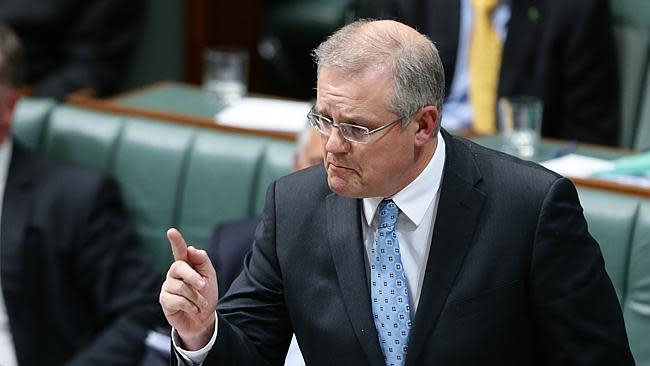
A fistful of dollars. That's the centrepiece of Scott Morrison’s 2018-19 federal budget. About $13 billion in tax cuts and a return to surplus are underpinned by rivers of revenue from corporate taxes pouring into Treasury coffers.
Unsurprisingly, the government has strategically targeted its core constituencies: middle-income earners; small business; pensioners; and major corporations. That this is unabashedly an election budget is borne out by the catch-all measures, with income tax cuts at the forefront.

This budget is also built on some robust assumptions. GDP growth is forecast at 3.0 per cent in 2018-19 and 2019-20. However, it's worth noting that Treasury GDP growth forecasts have been wrong every year since 2006-07. The wages outlook is also courageous, with 3.5 per cent growth forecast (currently, a languid 2 per cent).
If I were a rich man...
Middle Australia will get a sandwich-and-milkshake tax cut – but only if the Coalition is re-elected in 2019. Unusually, the cut will take the form of a refund, where middle-income voters will get a cheque in the mail for the princely sum of $550 in July 2019.
But the real target for reform is bracket creep; as incomes rise, workers are forced into higher tax brackets. The Coalition’s seven-year plan aims to abolish the 37.5 per cent tax bracket by 2024, replacing it with a 32.5 per cent tax rate on earnings up to $200,000 per annum. This means a flatter, less progressive income tax system. On this measure, the rich will only get richer.
This will be a costly tax cut; the hit to Treasury’s revenue base will be $14 billion over the first four years, and $140 billion over 10 years. There are good reasons for treasurers to lock in tax cuts – they're politically popular and are intrinsically difficult to reverse. Any opposition or government that jettisons tax cuts looks like Scrooge and risks damaging criticism for raising taxes.
When I’m 64
Older Australians clearly caught the government’s attention, with pensioners emerging as major budget beneficiaries. About $100 million will be devoted to mental health funding, and significant expenditure of $16 billion will be allocated to in-home care for elderly people. Retirees on the full pension, who own their own home, will be able to increase their cash incomes through a loan scheme that allows them to retain their pension benefits. Self-employed individuals can now earn up to $7800 per annum. There will also be wage subsidies of up to $10,000 for employees who take on older workers, costing the budget $189 million over five years.
You never give me your money
There are minor spending measures, such as $500 million for the Medical Research Future Fund, as well as technology investments by the government, including the national space agency, totalling $2.4 billion. However, the budget confirms the funding freezes for university courses, forecast in the government’s mid-year economic and financial outlook (MYEFO) in December 2017.
Taking care of business
Small businesses with turnover up to $10 million per annum will reap the rewards of an extension to the tax deduction on equipment purchases through 30 June, 2019. It remains capped at $20,000 per item. Farms purchasing machinery can also take advantage of the instant deductibility scheme.
Corporate tax cuts of $33 billion have already been pushed through by the government, but the rest remain blocked in the Senate. These cuts would progressively reduce corporate tax rates to 25 per cent over 10 years. The Trump administration’s dramatic cuts to corporate taxes in December 2017 delivered a comparative advantage to American firms, which will ultimately reduce US business tax rates to 20 per cent, and this will drive American domestic and foreign investment. The Turnbull government argues that similar measures are required in Australia to remain a globally competitive country for business investment.
Fixing a hole
In 2018-19, Treasury forecasts a deficit of $14.5 billion, before delivering a slender surplus of $2.2 billion a year ahead of schedule in 2019-20. The government is no longer borrowing to fund recurrent spending, such as welfare and pensions, but government debt will still reach $532 billion in 2028. On the revenue side, businesses are running out of deductions stemming from their losses during the Global Financial Crisis (GFC). This has delivered substantially more taxation receipts to the government in 2017-18.
The Treasurer claimed $7 billion has been recovered in corporate tax, and there is talk – but only talk – about how to address multinational corporate tax avoidance. Similarly, the government has yet to determine precisely how to tax the digital economy; at this stage, strategies are only at the discussion stage. However, there are measures to crack down on the black economy expected to reap $5.3 billion.
Storm front
This may not be enough to win voters back to the Coalition. There's nothing in this budget that addresses first-home buyers, affordable housing or rising inequality. Young voters and house hunters are unlikely to be wooed by minuscule tax cuts or infrastructure spending. That said, budgets almost never deliver a poll boost, but this one is unlikely to offend the average voter.
The IMF warned this week that as global debt has now ballooned to $US164 trillion, governments should be paying down debt during the upswing in the business cycle, rather than splurging on tax cuts. In this respect, the government has forecast only a small surplus of $2.2 billion in 2019-20, with gross national debt heading for $600 billion, and exceeding $500 billion for a decade throughout the 2020s. Governments like to talk about ‘net debt’ (i.e., liabilities minus assets) of about $350 billion. However, the reality is that interest is paid on gross debt. This has been the subject of considerable public criticism from former senior Liberals Peter Costello and John Hewson. Other countries are paying down their GFC debt; Australia is not. Concomitantly, Treasury expects corporate tax receipts to increase by $5.2 billion over the next four years; missing this target would threaten the surplus.
Australia’s exports are driven by raw materials and foodstuffs, as well as a large international education services market. On exports, Treasury assumptions are conservative in this budget, based around iron ore prices of $55 per tonne. Coal, Australia’s second-largest export, has a Treasury estimate of $120 per tonne by December 2018, despite current prices averaging $200. Nevertheless, if exports underperform substantially, or the exchange rate is volatile, the assumptions underpinning the budget could mean a major hit to the bottom line. ‘Known unknowns’ include potential collateral damage to the Australian economy buffeted by a trade war between Washington and Beijing.
But there’s one more ‘known unknown’ before the next election: will voters take the money and run?





